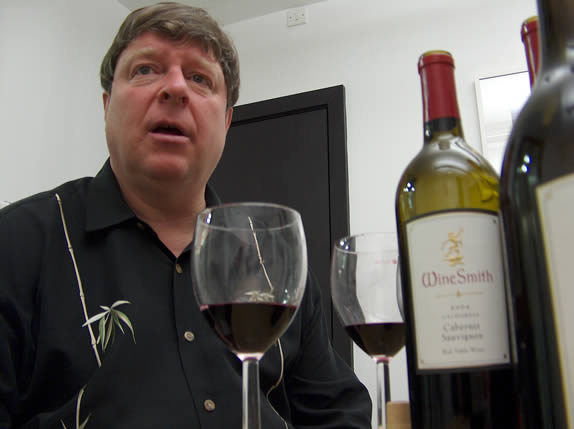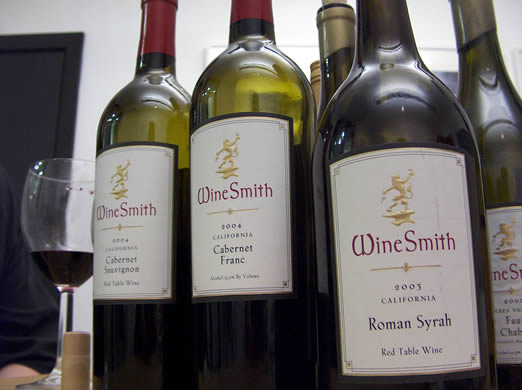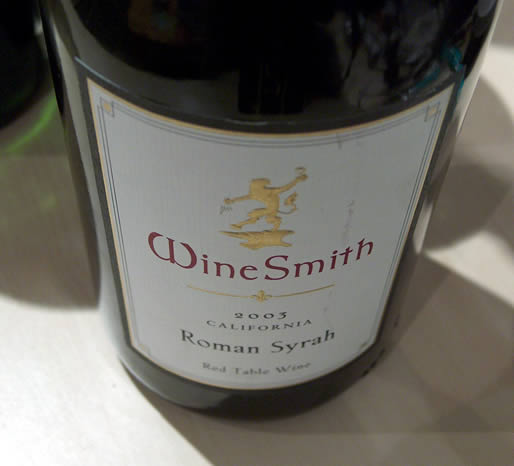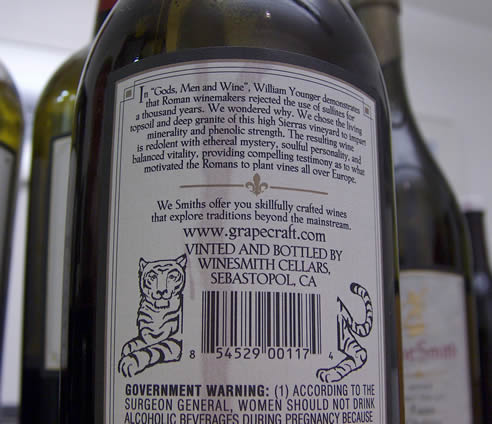|
Clark
Smith interview
the
surprising juxaposition of wine technology and natural wines

Clark Smith is a bit of a
paradox. You’d expect someone whose business is applying
hi-technology solutions to improving or correcting wine to be someone
easy to categorize as a modernist tecchie with no understanding of the
heart of wine. But Clark isn’t just a science guy who treats wine
like milk or soft drinks, as a commodity to be tamed by technology.
While he may dispute that there is such a thing as the ‘soul’ of
wine, his primary interested in the concept of deliciousness in wine,
rejecting sterile correct wines with no real personality—and he’s
even made his own ‘natural’ wine, without the use of added sulfur
dioxide. Read his grapecrafter
blog: it’s thoughtful and tackles
some of the most interesting issues in wine.
I spent some time with him
recently when he and his wife Suzie were in town. We met at his hotel
in South Kensington for a tasting, and then went out for dinner at
Tendido Cero, round the corner on the Old Brompton Road.
Clark spent two years at
MIT, beginning as a maths major, but he says that he couldn’t handle
it. He then switched to chemistry, but it looked pretty well worked
out. He says that he was looking for a place where enquiry into
science merged with inquiry into what it is to be a living thing. He
left and got a job in a liquor store. He realized that wine was a fun
playground and a place to make an impact. Two years later he started
getting patents. ‘There are only 150 patents in the history of the
wine industry’, says Clark. ‘No one in the industry was trying to
do anything new. I got interested in that.’ He adds that. ‘we are
trying to do something old, but we need new tools to do it.’ He is
somewhat dismissive of a reliance on wine science. ‘Around wine,
organized enquiry is not our goal’, says Clark. ‘Wine is liquid
music!’
‘Why is a major chord
happy and a minor chord melancholy?’ he asks. Clark talks of the
illusory nature of harmony. When an orchestra tunes up, there’s lots
of noise but not much harmony between the instruments. ‘But then
there’s music’, he says, ‘which is perceived as sad or joyful.
It carries emotion.’ This sounds more like a biodynamic winegrower
talking than it does a peddler of hi-tech wine solutions.
Smith refers to the work of
concert pianist Dr Manfred Clynes (see http://www.microsoundmusic.com/clynes.htm), who has written a book on the subject
of alpha rhythms. Clynes studied emotions and showed the shapes of them
in paintings. ‘The idea that emotions have shapes is shared strongly
among many people’, says Clark. ‘The emotionality that wine
carries is strongly shared.’ He starts with the idea of harmony and
dissonance. ‘You don’t need to be a musician to tell that
something is out of tune.’ His idea in working with wines is to get
them into a state where they are in tune; where they show harmony. To
do this, two of the tools he uses are microoxygenation, to build
structure, and reverse osmosis, to dial the alcohol down to find a
point of harmony, called a ‘sweet spot’. A portion of a particular wine is
treated by reverse osmosis to produce a reduced alcohol component,
which is then blended back in to the original wine to create a series
of wines at closely spaced intervals of alcoholic strength. When
groups of tasters go through these wines, some of them tend to stick
out as working better than others: these are the sweet spots. To
illustrate the concept, he’d brought along three wines, which were
treated versions of an Amador County Syrah that was originally 18%
alcohol, which represented the three sweet spots for this wine. These
wines were not tasted blind.
15.4%
Jammy and chocolatey. Sweet dark fruits nose is quite ripe and
smooth with liqueur-like fruit. The palate is ripe, full and spicy
with a bit of alcohol on the finish. It’s pure and dark but quite
alcoholic.
14.2%
Clark describes this as the ‘jammy in your face Californian
sweetspot’. A little bit fresher on the nose with ripe, smooth dark
fruits. The palate is bright and fresh with some nice smooth spicy
tannins. Sweet, still, but with the acid and tannins more apparent.
13.75%
Fresh nose is more peppery. The palate is full with some tannic
structure and fresh acidity, which sticks out a little. Focused,
fresher and pepperier.
Three very different wines, with the
only difference the alcoholic strength. ‘We do sweet spot tastings
with 2500 wines a year’, says Clark, ‘and we never get a bell
curve distribution of preference. It’s Gaussian, like tuning into
radio stations’. He reckons that just one in five of these
alcohol-adjusted wines seems to work. For example, the wine half way
between 2 and 3 didn’t taste very good: he says it comes across as
pretty tannic. ‘Wine is not linear’, maintains Clark. ‘We
can’t describe the pleasure we get from it because of its
constituents.’
Clark estimates that 45% of premium
Californian wines are alcohol adjusted, either by reverse osmosis, the
technique he developed, or the spinning cone. Alcohol reduction is
becoming a widely adopted tool throughout the winegrowing world, but
it is not without controversy, simply because it’s seen as a rather
artificial technique that subjects a portion of the wine to rather
dramatic physical forces.

We then tasted some of
Clark’s wines. He makes them under three different labels. The high
end wines are Winesmith, then there are two affordable labels,
Cheapskate and Penny Farthing.
see
http://www.cheapskatewines.com/
and http://www.winesmithwines.com/
Cheapskate Surly Chenin
Blanc 2005 Clarksburg
Lovely nose: appley, bright with a hint of cheesiness. The palate
is full, fresh and fruity with lovely broad fruit and good weight.
Even a hint of structure. Lovely stuff. Very good+ 86/100
Winesmith Faux Chablis
2002 Napa
From the student vineyard at the Napa Valley College, this
mischievously labelled wine began life with 14.8% alcohol. Now it’s
at 12.9. Clark says you can’t make this style of wine by just
picking early. No malolactic was used and the wine was fermented in
untoasted Allier oak. It has a fresh, pure, lemony nose that’s
delicate and mineralic. The palate is crisp with a fresh lemony
character. Quite a precise wine with some structure. Very good+ 89/100
(250 cases made and sells for US$30)
Winesmith Faux Chablis
2004 Napa
Quite focused and full with a crisp, bright palate and nice lemony
fruit. It’s tight and quite mineralic with good acid and nice focus.
Tasty stuff. Very good/excellent 90/100
Cheapskate Skinflint Rosé
2005
This rosé started life at 14.8% alcohol and it has been taken
down to 12.5%. Clark says that the extra alcohol was awful on the
nose, because the sweetness and roundness that this wine has is gone.
This is a nice orange/pink colour. Sweet, open nose leading to a fresh
but sweet palate that’s quite broad and fruity. A really lovely wine
that’s great value. Very good+ 88/100
Cheapskate Miser 2004
A meritage. Lovely sweet, pure ripe fruits nose with a bit of
graphite-like gravelly minerality. This leads to a palate that shows
lovely ripe, pure, smooth fruit with a nice minerally edge to the
palate. Delicious stuff. Very good/excellent 90/100
Penny Farthing Cabernet
Sauvignon 2004
Smooth, dark nose with a soya sauce edge and some minerals. The
palate shows a spicy, minerally edge to the ripe fruit. Very spicy.
Winesmith Cabernet
Sauvignon 2004
This was the cheapskate wine but it was elevated to the $18 level
by blending in 9% of the high-end Crucible. Lovely pure sweet aromatic
nose: broad, fine and sweet with some minerality and focus. The palate
is sweet and pure; rich and focused with a graphite-like minerality.
Very good/excellent 92/100
Winesmith Cabernet Franc
2004
This is made from two vineyards next to each other. The first has
deep alluvial soils and makes Cab Franc that is plummy, sweet and
round. The second has serpentine soils which are a bit toxic to vines,
which limits canopy vigour, resulting in a mean spirited Cab Franc
with tannins. The two wines blended together work well. Lovely
aromatic nose of sweet fruit with a leafy, spicy edge to it. The
palate is sweet and rich with a lovely intensity and some nice fresh
leafy notes, too, together with a hint of vanilla sweetness. Nice
spicy structure. Lovely stuff. Very good/excellent 91/100

We now turn to what is
Clark’s most interesting wine project, the Roman Syrah. He makes it
without any added sulfur dioxide (SO2) at all, and claims
that wines made with no SO2 show much greater aroma
expression. To do this, he needs to use a reductive variety, Syrah,
grown in an organic vineyard which produces wines with a very high
phenolic content: it’s this that protects the wine from the big
scourge of natural wines—oxidation. He’s now made four successful
vintages of this wine without SO2. How does he control
brett, which is the other key threat to natural wines? ‘Brett is a
hospital disease’, maintains Clark, ‘caused by sanitation and
German winemaking practices’. He likens his work to doing IPM
(integrated pest management) in the winery: ‘beneficial organisms
fight brett’.

Clark sees winemaking as the
work of a chef rather than that of a scientist. When a chef makes a
sauce, she or he will know when they’ve got it right by feel. Clark
builds structure in his reds by appropriate use of oxygen, which, when
delivered at the right stage and in the right levels, assists the
development of the tannins in appropriate ways. How much and when will
differ from wine to wine: this is where the winemaker behaves like a
chef. He notes that wines can usefully take much more oxygen before
sulfur dioxide additions than they can afterwards.
Winesmith Roman Syrah
2003
Sweet, pure, open nose with a bit of chocolatey character. Very
pure. The palate is savoury and tannic with nice spicy fruit and a
hint of funkiness. A very bold, intense sort of style. Quite rustic on
the finish, but also long and rich. It’s an unusual wine. Very
good/excellent 90/100
The Crucible is his top
wine. It’s a premium Napa Cabernet that’s been made with the
assistance of the usual Clark Smith technology, and which retails at
US$100.
Winesmith Crucible 2004
Napa
Smooth dark nose is sweet but quite complex and focused. There’s
lovely richness to the palate with good structure. Complex and refined
this is a serious wine of real appeal.
Winesmith Crucible 2005
Napa
Dark and intense with lovely perfumed fruit and firm,
mouth-coating tannins. Beautifully dark with firm structure: brilliant
stuff. Clark reckons this is the best Cabernet he’s made yet.
Winesmith Crucible 2006
Napa
This is a pre-malo sample, and so there’s lots of work yet to be
done on it. Lots of sharp green structure to the fruit.
Wines tasted 11/06
Find
these wines with wine-searcher.com
see also: an
earlier report on Clark and his wines, which focuses more on the
techniques he uses
Back to top
|

